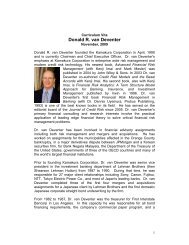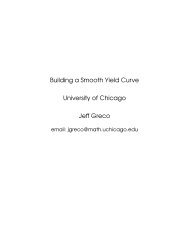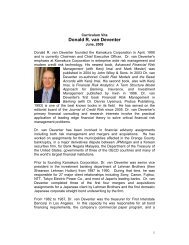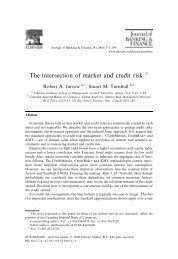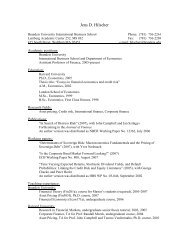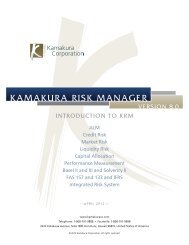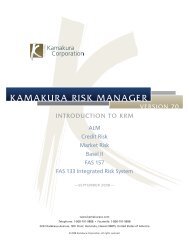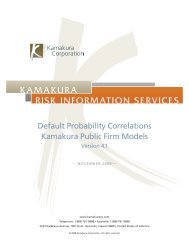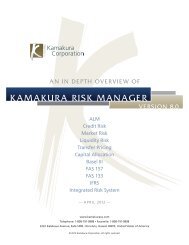KAMAKURA RISK INFORMATION SERVICES - Kamakura Corporation
KAMAKURA RISK INFORMATION SERVICES - Kamakura Corporation
KAMAKURA RISK INFORMATION SERVICES - Kamakura Corporation
You also want an ePaper? Increase the reach of your titles
YUMPU automatically turns print PDFs into web optimized ePapers that Google loves.
<strong>KAMAKURA</strong><br />
<strong>RISK</strong> <strong>INFORMATION</strong> <strong>SERVICES</strong><br />
VERSION 7.0<br />
<strong>Kamakura</strong> Public Firm Models<br />
Version 4.1<br />
— SEPTEMBER 2008 —<br />
www.kamakuraco.com<br />
Telephone: 1-808-791-9888 • Facsimile: 1-808-791-9898<br />
2222 Kalakaua Avenue, 14th Floor, Honolulu, Hawaii 96815, United States of America<br />
© 2008 <strong>Kamakura</strong> <strong>Corporation</strong>. All rights reserved.
Contents<br />
I. <strong>Kamakura</strong> Public Firm Models Introduction<br />
II. <strong>Kamakura</strong> Public Firm Models Benefits<br />
III. <strong>Kamakura</strong> Public Firm Models Applications<br />
IV. <strong>Kamakura</strong> Models of Default Probabilities<br />
a. Jarrow-Chava<br />
b. Merton<br />
V. Default Probability Correlations<br />
VI. Default Probability Estimates Subscriber Information<br />
VII. About <strong>Kamakura</strong> <strong>Corporation</strong><br />
2<br />
© 2008 <strong>Kamakura</strong> <strong>Corporation</strong>. All rights reserved.
I.<br />
Introduction<br />
The <strong>Kamakura</strong> Public Firm Models provide investors, investment managers, dealers,<br />
traders, lenders and auditors a simple, objective means of assessing the credit quality of<br />
credit-risky public firms. Credit quality is measured in terms of the probability of default of<br />
a credit-risky firm.<br />
<strong>Kamakura</strong>’s Public Firm Models offer many benefits to organizations that require a testable<br />
and reliable means for analyzing the credit quality of public firms:<br />
• Methodological benefits include objective quantification of firm default risk, use of<br />
information incorporating future expectations of firm default, and maximum utilization<br />
of available data.<br />
• Operational benefits include low cost credit analysis across a large number of credit-risky<br />
firms and high quality predictions of default likelihood.<br />
Individual firms are re-evaluated and updated daily based on financial information,<br />
macroeconomic factors, industry specific attributes and market based trading inputs.<br />
<strong>Kamakura</strong>’s Public Firm Models provide estimates of the full term structure of default<br />
probabilities of an individual firm based upon current public information about the firm,<br />
its economic environment, and the current risk of the public firms in its industry. The<br />
maturities that are available are 1 month, 3 months, 6 months, 1 year, 2 years, 3 years, and<br />
5 years. The Public Firm Models are part of <strong>Kamakura</strong> Risk Information Services (KRIS), a<br />
Web-based information service available by subscription.<br />
The <strong>Kamakura</strong> Public Firm Models provide unique advantages and superior results to credit<br />
market participants. Each firm is evaluated in the context of its industry sector. And in<br />
addition to incorporating endogenous variables, such as financial ratios, some of the Models<br />
also incorporate exogenous variables, such as economic conditions and industry risk, as<br />
recommended in Working Paper 126 of the “Bank for International Settlements,” authored<br />
by Linda Allen and Anthony Saunders.<br />
3<br />
© 2008 <strong>Kamakura</strong> <strong>Corporation</strong>. All rights reserved.
II.<br />
Benefits of the <strong>Kamakura</strong> Public Firm Models<br />
Objective<br />
Credit Quality<br />
Measurement<br />
Modern Default<br />
Correlation<br />
Technology<br />
Future Economic<br />
Expectations<br />
Maximum Utilization<br />
Of Historical Data<br />
High Performance<br />
Default Prediction<br />
Future Credit Quality<br />
Prediction<br />
Business Cycle<br />
Related Default<br />
Correlation<br />
Low Cost Credit<br />
Analysis<br />
Large Scale Credit<br />
Assessment<br />
Portfolio Analysis<br />
System Compatibility<br />
Daily Updates<br />
The Public Firm Models are statistical and option theoretic models measuring<br />
credit quality based upon objective relationships between observed<br />
default behavior and firm attributes, economic conditions, and industry<br />
risk or between market expectations embedded in equity prices and firm<br />
characteristics.<br />
The KRIS service includes the only pair wise correlations available in the<br />
industry for any model, any maturity, and any pair of companies in the full<br />
KRIS universe. It is no longer necessary to make the dangerous assumption<br />
that all companies in a portfolio have the same pairwise correlation.<br />
The Public Firm Models incorporate market equity price information that<br />
reflects investor expectations about the future performance of individual<br />
firms and their default potential.<br />
The multi-period statistical estimation approach incorporated in the Jarrow<br />
Chava and Jarrow Merton Hybrid Models maximizes utilization of historical<br />
default, financial and economic data observations often excluded in other<br />
models. This allows correct modeling of risk throughout the credit cycle.<br />
Default probability estimates provided by the Public Firm Models have shown<br />
historically high performance in predicting firm defaults across a wide range<br />
of credit-risky firms.<br />
Users of the Public Firm Models can estimate the default probability of a firm<br />
at a future point in time by incorporating estimates of firm characteristics and<br />
economic conditions at that time.<br />
Default probability correlations provided for the Jarrow Chava and Jarrow<br />
Merton Hybrid Models are correlated through dependent behavior of<br />
underlying economic explanatory variables.<br />
The Public Firm Models offer an objective assessment of credit quality<br />
without requiring high cost credit analysts or credit modelers and extensive<br />
commitment of internal resources.<br />
The low cost of analyzing individual firms and the use of a quantitative model<br />
allows users to apply the Public Firm Models to a large number of credit-risky<br />
firms at a reasonable cost.<br />
Default probabilities obtained from the Public Firm Models can be<br />
consistently and directly incorporated in portfolio valuation, cash flow and<br />
net income analyses in the <strong>Kamakura</strong> Risk Manager software.<br />
Default probability, default correlation, implied ratings and implied spreads<br />
are updated daily based on company specific financial information, observed<br />
market prices, changes in macroeconomic variables and other factors.<br />
4<br />
© 2008 <strong>Kamakura</strong> <strong>Corporation</strong>. All rights reserved.
III.<br />
Applications<br />
Applications of the Public<br />
Firm Models range from<br />
relatively simple analyses of<br />
firm creditworthiness to creditadjusted<br />
valuation, cash flow and<br />
net income analyses of a firm’s<br />
obligations to credit-adjusted<br />
portfolio risk measurement using<br />
<strong>Kamakura</strong> Risk Manager or other<br />
enterprise risk management<br />
software. A partial list of potential<br />
applications is shown in the<br />
accompanying diagram.<br />
Investment management firms<br />
can use the Public Firm Models<br />
to identify potential trading<br />
opportunities. Default probabilities<br />
produced by each of the Models<br />
can be used to rank firms with the<br />
same agency credit rating based<br />
on estimated default probabilities.<br />
For example, firms with the<br />
highest default probabilities<br />
assigned a ‘BBB’ credit rating can<br />
be identified, as shown in the<br />
Ranking Page diagram.<br />
Default probabilities produced by<br />
the Public Firm Models can also<br />
be used to estimate fair values for<br />
potential investments on a creditadjusted<br />
basis, and these estimates<br />
can be compared with actual<br />
investment pricing to determine<br />
the value of the investments.<br />
Applications of the <strong>Kamakura</strong> Public Firm Models<br />
Comparing And Ranking Firm Creditworthiness<br />
Compare firm default probabilities to determine relative<br />
creditworthiness of public firms<br />
Modeling Correlated Default in CDOs and Portfolios<br />
Use firm default probabilities and default correlations to more<br />
realistically model “tail risk” from default in CDOs and portfolios of<br />
bonds or loans<br />
Assisting Credit Approval Decisions<br />
Reduce credit losses by incorporating default probabilities into credit<br />
approval processes for public firms<br />
Monitoring Changes In Firm Creditworthiness<br />
Observe changes in public firm credit quality to identify credit<br />
deterioration prior to its reflection in debt market prices<br />
Simulating Credit-Risky Firm Defaults<br />
Use default models to simulate the timing of potential defaults of<br />
credit-risky public firms on a realistically correlated basis<br />
Estimating Credit-Risky Firm Credit Spreads<br />
Use public firm default models and obligation recovery models to<br />
estimate the credit yield spread required by investors<br />
Valuing Credit-Risky Firm Obligations<br />
Use credit-risky public firm credit spread models and instrument<br />
valuation models to estimate instrument values for credit-risky firms<br />
Comparing Credit-Risky Trading Opportunities<br />
Compare pricing of credit-risky public firm debt priced using estimated<br />
default probabilities vs. observed market prices<br />
Simulating Credit-Adjusted Cash Flows And Income<br />
Use public firm credit models and instrument cash flow and income<br />
models to estimate future credit-adjusted cash flow/income<br />
Hedging Portfolio Value And Cash Flows<br />
Use public firm credit, correlation and instrument models to improve<br />
estimated hedges of credit-adjusted portfolio value and cash flows<br />
Measuring Portfolio Value At Risk<br />
Use public firm credit models, correlations and instrument valuation<br />
models to estimate the probability distribution of credit-adjusted<br />
portfolio value<br />
Measuring Portfolio Stochastic Cash Flow And Income<br />
Use public firm credit, correlation and instrument models to estimate<br />
the probability distribution of credit-adjusted portfolio cash flow/<br />
income<br />
Estimating Portfolio Regulatory And Economic Capital<br />
Use public firm credit-adjusted portfolio value distribution to estimate<br />
regulatory/economic capital requirement for the portfolio<br />
Banking firms can use the Public Firm Models to satisfy their requirements for a Probability<br />
of Default (PD) model for their public firm clients under the proposed Basle II guidelines<br />
for both the Foundation and Advanced versions of the Internal Ratings Based approaches.<br />
Since the Public Firm Models describe relationships between firm defaults and firms’<br />
5<br />
© 2008 <strong>Kamakura</strong> <strong>Corporation</strong>. All rights reserved.
characteristics and economic conditions, they can be objectively tested for statistical<br />
significance and predictive power. The results of these tests are available to Public Firm<br />
Model clients in the KRIS Version 4.1 Technical Guide, which has been reviewed with the<br />
Federal Reserve Board, the Federal Reserve Bank of New York, the Office of the Comptroller<br />
of the Currency, the FSA in the United Kingdom, the Bank of England, the Bank of Japan,<br />
and many other regulators around the world. These test results and documentation are<br />
expressly designed to satisfy the Basle II requirements for an internal validation process<br />
to assess the performance of the bank’s internal rating and risk quantification systems<br />
consistently and meaningfully.<br />
Dealers and other participants in the capital and derivatives markets will find the Public<br />
Firm Models useful in the analysis of both long-term credit risk and short-term settlement<br />
risk of counterparties to their trades. Default probabilities for their counterparties can<br />
be combined with measures such as potential future exposure to provide an estimate of<br />
expected credit losses across their trading books.<br />
The Public Firm Models service also offers estimates of the correlation between the default<br />
probabilities of pairs of firms. Subscribers can identify a collection of firms for which default<br />
probability correlations are required and can obtain an estimated correlation matrix for this<br />
collection, as shown in the Correlation Page diagram.<br />
All types of organizations with credit-risky portfolios can apply the Public Firm Models<br />
as a basis for credit-adjusted portfolio risk measures, such as Value at Risk or Earnings at<br />
Risk. Users can combine default probabilities from the Public Firm Models with appropriate<br />
6<br />
© 2008 <strong>Kamakura</strong> <strong>Corporation</strong>. All rights reserved.
valuation, cash flow and net income models like KRM. For various types of portfolio<br />
instruments, the future value, cash flows and net income of a portfolio can be estimated<br />
under alternative simulated stochastic scenarios. The required risk measures can then be<br />
calculated using the resulting future value, cash flow and net income distributions. This<br />
allows the financial risk of large portfolios of loans, derivatives and other instruments with<br />
credit exposure to public firms to be measured and allows macro-factor portfolio hedges to<br />
be established. The risk measures also provide a basis for estimating the economic capital<br />
required to offset potential economic losses for a portfolio of public firm obligations.<br />
<strong>Kamakura</strong>’s Public Firm Models are based on advanced statistical and option pricing<br />
modeling technology that maximizes the use of available information and provides a high<br />
level of predictive performance. Some of the technical details of the Model are described in<br />
the accompanying diagram. Together with <strong>Kamakura</strong>’s Business Mortality Model for small<br />
to medium sized companies, these Models offer subscribers a comprehensive solution to<br />
assessing the creditworthiness of the entire spectrum of credit-risky firms.<br />
IV.<br />
Modeling Default Probabilities<br />
<strong>Kamakura</strong>’s Public Firm Models currently offer four different quantitative approaches to<br />
modeling default probabilities: two versions of the Jarrow Chava Model (KDP-jc), the<br />
Merton Structural Model (KDP-ms), and the Jarrow Merton Hybrid Model (KDP-jm).<br />
Both the third generation (version 3.0, released in October 2004) and the fourth generation<br />
(version 4.1, released January 9, 2006) of the Jarrow-Chava models are available on the web<br />
site at the request of the KRIS client base. All of these approaches incorporate information on<br />
market prices of firm equity and interest rates, so that current market expectations are fully<br />
reflected in the default probability estimates. The availability of multiple Public Firm Models<br />
provides subscribers with theoretically sound alternative views on the likelihood a particular<br />
firm will default.<br />
The Jarrow Chava Model<br />
The Jarrow Chava Model is a statistical hazard model that relates the probability of firm<br />
default to several explanatory variables. The explanatory variables include firm financial<br />
ratios, other firm attributes, industry classification, interest rates and information about<br />
firm and market equity price levels and behavior. In this model, firm default can occur<br />
randomly at any time with an intensity determined by the explanatory variables. Originally<br />
developed by <strong>Kamakura</strong>’s Director of Research, Robert Jarrow, the Jarrow Chava Model<br />
provides an objective, statistically reliable method of predicting potential firm defaults. The<br />
Federal Deposit Insurance <strong>Corporation</strong> of the United States announced in December 2003<br />
that it was adopting the methodology incorporated in the Jarrow Chava Model for its Loss<br />
Distribution Model for the bank and savings and loan insurance funds. Both the third and<br />
fourth generation Jarrow-Chava models incorporate multiple equations for forecasting<br />
default at different forward time intervals, conditional on survival to that point in time.<br />
These equations share the same inputs but they have different weightings depending on the<br />
7<br />
© 2008 <strong>Kamakura</strong> <strong>Corporation</strong>. All rights reserved.
time horizon. The current and forward conditional default probabilities are combined to<br />
derive the full default term structure out to five years.<br />
Merton Structural Model<br />
The Merton Structural Model uses option pricing methods to relate the probability of firm<br />
default to its financial structure and information about the firm’s market price of equity. The<br />
explanatory variables include a measure of the firm’s outstanding debt, its market valuation,<br />
and information about firm and market equity price behavior. In this model firm default<br />
occurs when the market value of the firm’s assets decline below a threshold related to the<br />
firm’s outstanding debt. Robert Merton, winner of the Nobel Prize in Economic Sciences in<br />
1997, originally developed this model.<br />
Jarrow Merton Hybrid Model<br />
The Jarrow Merton Hybrid Model is a statistical hazard model that relates the probability<br />
of firm default to the same explanatory variables as the Jarrow Chava Model, but it also<br />
incorporates the default probability of the Merton Structural Model as an additional<br />
explanatory variable. In this model, firm default can occur randomly at any time with an<br />
intensity determined by the explanatory variables. <strong>Kamakura</strong> offers this Model to combine the<br />
default prediction capabilities of the associated models. Forward default probabilities and the<br />
full term structure of default are derived in the same fashion as for the Jarrow-Chava models.<br />
V.<br />
<strong>Kamakura</strong> Default Probability Correlations<br />
The Wall Street Journal reported on August 12, 2005 about the very large hedge fund losses<br />
that occurred in May when GM and Ford were downgraded. Many traders held long positions<br />
in the bond and short positions in the common stock, a common hedging strategy for those<br />
who believe that the Merton model is an effective hedging tool. Unfortunately the Merton<br />
implication that stock prices and debt prices move in the same direction is true only about<br />
8<br />
© 2008 <strong>Kamakura</strong> <strong>Corporation</strong>. All rights reserved.
half the time (see van Deventer and Imai, Credit Risk Models and the Basel Accords, John<br />
Wiley & Sons, 2003) and traders suffered large losses from this kind of strategy in the GM<br />
and Ford cases. For this reason, <strong>Kamakura</strong> Risk Information Service (KRIS) users asked<br />
<strong>Kamakura</strong> to develop pair-wise default probability correlations that go far beyond the basic<br />
Merton/Copula approach. The KRIS web site now offers pair-wise default correlations for<br />
all companies in the universe for all maturities and for all models. As of July 2007, the KRIS<br />
web site includes coverage of 18,000 companies in 29 countries. The total number of pair wise<br />
default correlations available on KRIS is more than 2.8 billion.<br />
VI.<br />
Default Probability Estimates Subscriber Information<br />
Subscribers may obtain default probability estimates in two ways:<br />
• The KRIS web site provides individual firm inquiry and Excel download capability by<br />
entering a firm’s financial and industry information into a Web form displayed in a<br />
browser, as shown above for Calpine, which defaulted in December, 2005<br />
• The second method for using the KRIS default probability service is by file transfer<br />
protocol (FTP). <strong>Kamakura</strong>’s KRIS power users make use of this technology to download<br />
the entire KRIS default probability history back to 1990 in order to scan for arbitrage<br />
opportunities. Most power users download new default probabilities daily.<br />
9<br />
© 2008 <strong>Kamakura</strong> <strong>Corporation</strong>. All rights reserved.
Technical Specifications<br />
Model Type<br />
Statistical hazard rate (“reduced form”) model with conditioning variables (Jarrow Chava and Jarrow<br />
Merton Hybrid Models)<br />
Asset value option pricing (“structural”) model with firm debt and equity market variables (Merton<br />
Structural Model)<br />
Default Database<br />
More than 1,700 defaults in North America through October, 2004 with expansion to other regions in<br />
progress (Jarrow Chava and Jarrow Merton Hybrid Models)<br />
Explanatory Database<br />
More than 1.4 million observations beginning in 1990 in North America (Jarrow Chava and Jarrow<br />
Merton Hybrid Models) and a research data base back to 1963<br />
Model Test Results and Parameters Fully Disclosed<br />
The KRIS Technical Guide includes ROC accuracy ratios, forward ROC accuracy ratios, van Deventer<br />
and Wang test for cyclical consistency of expected and actual defaults, and complete out of sample<br />
test results.<br />
Statistical Estimation Methodology<br />
Multi-period logistic regression with macro-factor inputs<br />
Statistical Performance<br />
All regression parameters statistically significant at the 95% level<br />
VII.<br />
About <strong>Kamakura</strong> <strong>Corporation</strong><br />
Founded in 1990, <strong>Kamakura</strong> <strong>Corporation</strong> is a leading provider of risk management<br />
information, processing and software. <strong>Kamakura</strong> has been a provider of daily default<br />
probabilities and default correlations for listed companies since November, 2002. <strong>Kamakura</strong><br />
launched its collateralized debt obligation (CDO) pricing service KRIS-CDO in April 2007.<br />
<strong>Kamakura</strong> is also the first company in the world to develop and install a fully integrated<br />
enterprise risk management system that analyzes credit risk, market risk, asset and liability<br />
management, transfer pricing, and capital allocation. <strong>Kamakura</strong> has served more than 185<br />
clients ranging in size from $3 billion in assets to $1.6 trillion in assets. <strong>Kamakura</strong>’s risk<br />
management products are currently used in 27 countries.<br />
<strong>Kamakura</strong> has world-wide distribution alliances with Fiserv (www.fiserv.com), Unisys (www.<br />
unisys.com), and Zylog Systems (www.zylog.co.in) making <strong>Kamakura</strong> products available in<br />
almost every major city around the globe.<br />
2222 Kalakaua Avenue, 14th Floor<br />
Honolulu, Hawaii 96815<br />
United States of America<br />
Telephone: 1-808-791-9888<br />
Facsimile: 1-808-791-9898<br />
Information: info@kamakuraco.com<br />
www.kamakuraco.com<br />
10<br />
© 2008 <strong>Kamakura</strong> <strong>Corporation</strong>. All rights reserved.



